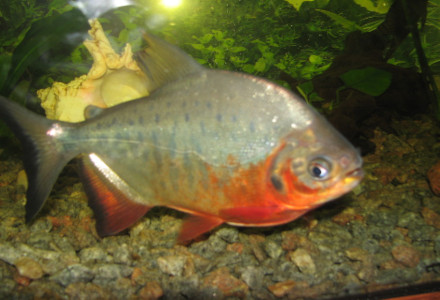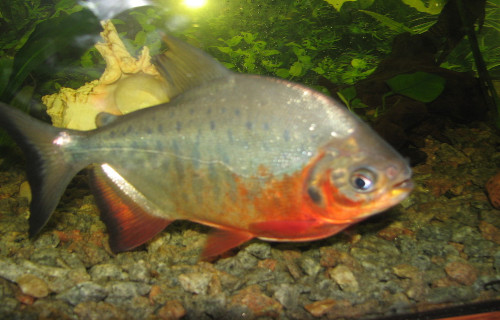We sincerely hope that you enjoy this article about 3 Extraordinary Freshwater Fish. Fish appear throughout the fresh waters of the world, of course. But, some just seem to stand out from the crowd. Obviously, these represent only a few of the unusual species to be found. But, we hope that these serve to whet your appetite to learn of more.
Royal Panaque
Royal Panaque Facts
- Leading off this article about 3 Extraordinary Freshwater Fish comes the remarkable species known as the Royal Panaque.
- The eye-catching term of Royal Panaque serves the creature it belongs to quite well. That statement holds true given the fact that it serves as the common name for a recently discovered species within an extraordinary fish genus.
- In fact, it’s also a very limited group of species. In point of fact, we currently know of only seven known species in this truly unique animal genus. Distinctly, it also bears the scientific name of the Panaque nigrolineastus.
- Like all the other incredible species contained in the genus, it stands out for one reason. But, this animal remains a truly unique one. That’s since, like its related species, it represents an astonishing act of evolution in Nature.
- Furthermore, the remarkable creature classifies as what many have given the name of armored catfish. Further, its most astonishing characteristic, and the one that separates it from most other fish, will utterly amaze those new knowledge of it.
- That holds true due to a somewhat surprising reason, though. That’s the fact that the completely distinguishing trait of this recently discovered animal remains the nature of its entirely unique dietary habits. That’s due to one amazing fact.
- The amazing Royal Panaque ranks as one of only a handful of fish species of its kind. As a result of an evolutionary adaptation, it and its relatives actually consume wood. When and why this evolutionary divergence occurred remains a mystery.
Royal Panaque Physical Description
Most notably, physically, at least, the remarkable Royal Panaque also sets itself apart from other fish in another way. That’s because it does not possess scales as most other fish do. In fact, the body of this unique creature grows encased in relatively heavy armor.
Yet, the process of evolution did leave it one vulnerability. In point of fact, the lone exception to this protection remains the underside of the animal. This part of the body of the fish remains soft. That, therefore, represents the Achilles Heel of the animal.
Furthermore, in coloring, the Royal Panaque appears principally a light gray. However, variations of this coloring do occur. Horizontally oriented dark gray squiggles also run the length of the body. As a result, it has a highly distinctive visual appearance.
The fascinating animal also attains an average length measuring roughly 17 in (43 cm). Due to the weight of its armor, it remains a poor swimmer. However, the animal does possess a powerful sucker-like mouth. This it uses to cling to rocks or submerged logs.
- Kingdom: Animalia
- Phylum: Chordata
- Class: Actinopterygii
- Order: Siluriformes
- Family: Loricariidae
- Genus: Panaque
- Species: P. nigrolineatus
Royal Panaque Distribution, Habitat, and Ecology
One understandably sad fact about the recently discovered, and truly fascinating, Royal Panaque exists. That’s the fact that this remarkable work of Nature has a quite specific habitat range. In this, it echoes the characteristics of its few related species.
It appears to have evolved as solely endemic to the large river basins in the countries of Colombia, Brazil, and Venezuela. More specifically, these river basins consist of two regions already well known for the great diversity of life within their confines.
In fact, they form two enormous, and vitally important locations in the region. These, in fact, consist of the mighty Amazon River Basin, and the Orinoco Basin. More specifically, these two regions of diversity are located in South America.
Remarkably, the truly incredible Royal Panaque holds one highly distinctive secret. To the amazement of many individuals, the fish appears to have evolved as fully herbivorous in nature. However, this characteristic holds true with one unique adaptation.
The fascinating fish consumes not only algae but also feeds on something truly amazing. You see, this wonder of Nature evolved the ability to consume wood. Highly specialized bacteria in its digestive tract make this astounding feat possible.
Pacu
Pacu Facts
- The third amazing entry into this compilation of 3 Extraordinary Freshwater Fish is the incredible Pacu.
- First of all, the short term serves as the collective name for any of several related species of carnivorous freshwater fish. To no great surprise, these astonishing looking creatures also bear a close relationship to the piranha.
- However, the primary physical differences between the two appear in dentition and physical size. In addition, the members of this equally amazing group also remain renowned for the extraordinarily unique teeth they possess.
- Nevertheless, unlike its genetic relative, the piranha, the teeth of the Pacu develop a most distinctive shape. That’s because these develop as square and flat. In fact, in a bizarre twist of evolution, these strongly resemble those evolved by human beings.
- Furthermore, the terrifying looking fish also distinguishes itself in another way. It grows to a much greater size than its much smaller cousin the piranha. Unfortunately for the completely benign species, its size makes it far more dangerous-seeming than it actually is.
- Additionally, despite its rather terrifying form, the Pacu actually poses no danger to humans. This occurs, not because of its size or dentition, but due to the specific nature of its dietary habits. Sadly, its numbers appear to be diminishing.
Pacu Physical Description
In purely general terms, the various forms of the Pacu basically resemble their cousin, the smaller piranha. That is, except for the completely astonishing dentition and sheer physical size. These factors clearly set these creatures apart from any related species.
Firstly, the remarkable fish commonly attains a comparatively large length. In point of fact, the impressive animal reaches lengths measuring as much as 3 ft (0.9 m). It also achieves great mass. That holds true given the fact that its weight sometimes reaches as much as 55 lb (25 kg).
Secondly, since the common name of Pacu applies to different species, coloring varies between them. But, a few shades appear to dominate. These include colors such as gray, silver, red, and black. The reason these most commonly predominate remains unknown.
- Kingdom: Animalia
- Phylum: Chordata
- Class: Actinopterygii
- Order: Characiformes
- Family: Serrasalmidae
Pacu Distribution, Habitat, and Ecology
The various types of Pacu thrive in the majority of streams and rivers in South America. Yet, the majority of species and individuals live in the Orinoco Basin and the Amazon Basin. There, the group of species also comprises a respectable portion of the highly diverse fauna.
The collection of fish species also appears to be popular in large aquariums. This leads to a serious environmental hazard, however. When it outgrows its tanks, many individuals simply dump the fish into the local waterways. Given its voraciousness, it often becomes highly invasive.
Due to this dumping, an extreme artificial spreading of the Pacu has occurred. Individual specimens have been caught in the wild in truly diverse locations. These even include such places as Scandinavia, Sweden, and even in the river Seine, in Paris, on August 30, 2013.
Despite its truly fearsome appearance, the Pacu poses no appreciable threat to humans. The animal feeds on a wide variety of plant material, and not on animal flesh. In its native territory range, members of this group of fish continue to be commonly farmed and fished.
Arapaima Leptosoma
Arapaima Leptosoma Facts
- Our final entry into this compendium of 3 Extraordinary Freshwater Fish is the fabulous species known as the Arapaima Leptosoma.
- Firstly, the highly surprising animal actually constitutes a recently discovered type of freshwater fish. Most unfortunately, to date, researchers actually know of only a few individuals of this new remarkable species.
- Also, awareness of its existence occurred so recently that no common name for this species exists as of yet. Quite understandably, the search for more of its kind remains ongoing in the region in which the discovery occurred.
- This truly startling creature also represents another milestone for this field of scientific endeavor. Quite amazingly, the truly distinctive creature forms the first newly recognized species of Arapaima discovered since 1847.
- Obviously, no data concerning the numbers of the Arapaima Leptosoma exist yet. But, the IUCN considers it to be a threatened species. However, this classification occurs due to the fact that all fish species endemic to the region appear to be threatened by overfishing.
Arapaima Leptosoma Physical Description
The fact that so few specimens have been observed limits the confirmed knowledge of the species. Therefore, only general information concerning the species remains known at this time. But, in color, the creature presents a combination of grayish-silver and red.
All other species of Leptosoma have one surprising fact in common. All of them appear to be among the largest known species of freshwater fish. The reason why this shared trait exist forms another mystery. Researchers thus consider it likely that this species attains a similar size.
Like all other members of its family, it evolved another distinctive characteristic. It actually developed as an air-breathing fish. In addition, the individuals so far discovered seem to represent mature adults. As a result, experts consider them representational of the species.
Finally, the most noted specimen of the Arapaima Leptosoma reached an astounding size. It actually measured about 10 ft (3 m) in length. Also, this animal does separate itself from its relatives in one manner. This species achieves a relatively long and thin physical shape.
- Kingdom: Animalia
- Phylum: Chordata
- Class: Actinopterygii
- Family: Arapaimidae
- Genus: Arapaima
- Species: A. leptosoma
Arapaima Leptosoma Distribution, Habitat, and Ecology
Researchers discovered the Arapaima Leptosoma within the waters of the Purus River. As a local river, this primarily flows in the Amazon Basin, in South America. In a truly fortuitous turn of events, the discovery of this enormous fish happened quite by accident.
The habitat of the impressive creature generally tends to be a wide, slow-moving river. However, numerous eddies of various sizes and strengths also exist along its course. At this time, it remains unknown exactly which, if any, of these the creature prefers.
Given the limited number of specimens examined to date, a knowledge gap exists. Scientists understandably have little reliable specific data as to its life cycle. But, the great majority of these scientists assume this characteristic to be similar to other varieties of Leptosoma.
If so, the dietary habits of the Arapaima Leptosoma likely consist of the consumption of a variety of prey. This would mainly include small fish and crustaceans. Nevertheless, given its size, its diet might also include small land animals that venture too close to the water.
Finally, its uniqueness has served to popularize the creature. Despite the limited number of individuals available for study, a few individuals now appear in aquariums. Further research still remains ongoing into this amazing and, for now, somewhat mysterious creature.
3 Extraordinary Freshwater Fish
We truly hope that you have enjoyed this article about 3 Extraordinary Freshwater Fish. These few represent just a small fraction of the unusual varieties to be found throughout the world, of course. But, they perfectly prove the point that Nature loves variety. However, some of these species, like many others around the globe, now find themselves in danger. It’s up to each of us to do all that we can to protect and preserve them.
Check out our other articles on 6 Extraordinary North American Reptiles, 7 Highly Unusual Lakes, 5 Stunning Asian Lepidoptera, Astounding Lizards of the World, 5 Phenomenal Sea Turtles


